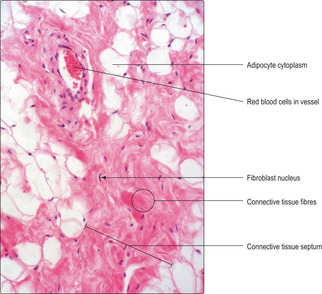connective tissue
Blood may be categorised as a connective tissue since its cells arise from mesoderm, but the extracellular matrix (plasma) is fluid (Chapter 8). Bone and cartilage are classified as connective tissues and they have an extracellular matrix that is relatively solid. In the case of bone, the matrix is mineralised with calcium salts which confer rigidity to the bone and the ability to resist deforming forces (Chapter 9).
Cell types in connective tissue (excluding blood, bone and cartilage)
The major cell type found in many connective tissues is the fibroblast. In many instances, fibroblasts are identified by their densely stained, elongated nuclei which do not appear to be associated with much cytoplasm (Figs 4.1 and 4.2). Fibroblasts secrete long, fibre-like protein molecules (e.g. collagen and elastin) and many of the other large molecules in the extracellular matrix.
If connective tissue is damaged, it may be repaired by the ability of fibroblasts to undergo mitosis and to synthesise new matrix. If fibroblasts are actively secreting matrix proteins, their appearance is changed: their nuclei are larger and relatively palely stained and nucleoli are apparent (Chapter 3, see Fig. 3.2). This appearance is a result of the activity of the DNA (and nucleolus) in the synthetic processes which produce new molecules for the extracellular matrix. (Conventionally, a cell with the suffix ‘blast’ indicates a rapidly dividing cell. However, in the case of the fibroblast, the term is usually reserved for the differentiated non-dividing cell, which might more appropriately be known as a fibrocyte.)
Several other types of cell occur in connective tissues; some are restricted to a particular type of connective tissue and others to the functional state of the tissue.
They are:
■ mast cells, which store granules containing specific molecules (e.g. histamine). When released from mast cells these molecules modify the permeability of blood vessels as part of an inflammatory reaction (Chapter 8)
■ macrophages, which are able to phagocytose and digest bacteria and cell debris. They are also able to phagocytose, but not digest, inert substances, e.g. carbon particles. In addition, they aid the immune response to antigens (Chapter 8)
■ white blood cells and plasma cells, which may be in transit through the connective tissue or responding locally as part of an immune response (Chapter 8)
■ adipocytes, which store fats (lipids) in their cytoplasm (Fig. 4.1). The fats may be metabolised and provide energy and various metabolites when needed. Adipocytes also provide insulation, give shape to the body and act as physical protection, e.g. around the kidney.
Extracellular matrix of connective tissue
Ground substance
Ground substance is a complex mixture of large molecules containing carbohydrates and protein, and tissue fluid containing water, salts, other small, soluble molecules and dissolved gases. The tissue fluid component ensures gases and nutrients move readily between blood vessels and connective tissue cells and other cells in the region. The large molecules (glycoproteins, proteoglycans and glycosoaminoglycans) bind the components of the extracellular matrix together altering the viscosity of the gel-like matrix and conferring on it different properties. In addition, the matrix molecules act as adhesion sites for various transient cell types which may be involved in immune responses.
Protein fibres
The protein fibres that are present in extracellular matrix of connective tissues are of two main types: collagen and elastin. Collagen is characterised by tensile strength and elastin by elasticity.
Collagen
Collagen is synthesised by fibroblasts and about 20 types have been identified but only a few are common. Different types of collagen are found in specific locations:




■ types I and II collagen are in bone and skin (Fig. 4.2) and provide strength
■ type II is in cartilage and provides strength and allows some distortion and recoil
■ type III (known as reticulin) provides fine supporting fibres, e.g. for liver cells (Fig. 4.3)
Stay updated, free articles. Join our Telegram channel

Full access? Get Clinical Tree




